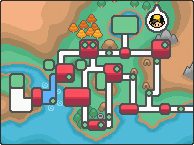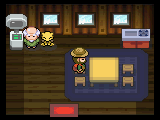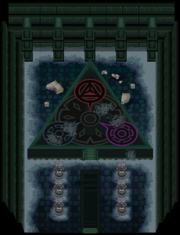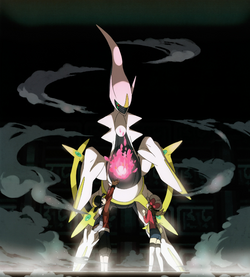Sinjoh Ruins
| ||||
| ||||
| Map description: | A snow-covered area of old legends, surrounded by a wall of snow. | |||
|---|---|---|---|---|
| Location: | North of Johto | |||
| Region: | Unknown | |||
| Generations: | IV | |||
 Location of Sinjoh Ruins in an unknown region. | ||||
| Pokémon world locations | ||||
The Sinjoh Ruins (Japanese: シントいせき Shinto Ruins) are a location in Pokémon HeartGold and SoulSilver that are not part of any known region. Their major feature is the Mystri Stage (Japanese: みつぶたい Mystri Stage), a triangular stage inside the ruined temple.
The only way to access the Sinjoh Ruins is by bringing an Arceus from an event distribution or the Hall of Origin to the Ruins of Alph. The event is triggered by having Arceus as the player's walking Pokémon and entering the Ruins of Alph. However, due to the Azure Flute never being released in Generation IV, it is not possible to obtain an Arceus from the Hall of Origin without the use of glitches, or cheating.
In the games
The Sinjoh Ruins are outside the range of the map, and therefore are not part of the regions of Kanto or Johto. It is unknown where exactly they are in relation to Sinnoh and Mt. Coronet; the only hint to their location is the Pokégear's map of Johto pointing far north of Blackthorn City and northeast of the Lake of Rage. They can be visited by way of a mysterious entry point in the Ruins of Alph created by the Unown and Arceus.
Fly and Teleport cannot be used to leave the Sinjoh Ruins, though an elderly man with an Abra who is staying in the cabin offers to teleport the player back home (much like the old man and his Abra at the Indigo Plateau in Generation II). If the player leaves before talking to Cynthia, when they return to the Ruins of Alph with Arceus all of the events will be repeated as if nothing had happened (including the Hiker meeting the player at the entrance).
The creation event that takes place here includes real-life pictures. This is the first time this has happened in any of the Pokémon games.
Historical background
As revealed by Cynthia and a Hiker in the cabin, the Sinjoh Ruins are the remains of a temple created hundreds of years ago by two groups of humans: one who had come from Sinnoh, and another who had hailed from Johto, or specifically the Ruins of Alph. Because of this, the ruins contain elements of both the Spear Pillar and the Ruins of Alph, as a sign of the blending of the two cultures. It is unknown what brought the two clans together to build a temple for Arceus, but this probably has to do with the underlying relationship between it and the Unown.
Arceus event
The event is triggered when the player tries to enter the Ruins Research Center at the Ruins of Alph with Arceus as their walking Pokémon. The lead archaeologist bumps into the player on his way out and is surprised that the player has Arceus. He then asks the player to come with him into the ruins to investigate a mystery. The scene cuts and the player, the lead archaeologist, and Arceus have just entered B1F of the Ruins of Alph. The lead archaeologist comments that something feels different this time to all the other times he has been in the ruins, and that he feels like the pictures on the walls are staring at him. The screen fades to black.
The player and Arceus are teleported to the inside of the Sinjoh Ruins. Upon stepping outside, a Hiker notices the player and comments that it is strange for someone so young to be interested in the ruins. He then talks about how the ruins show a blend of the cultures of Sinnoh and Johto. The Hiker then invites the player to talk inside the cabin rather than in the snow and walks off towards the cabin.
Inside this cabin, Cynthia is sitting at a table, and tells the player how the Sinjoh Ruins remind her of Sinnoh. She also mentions that the people of Sinnoh migrated here and built a temple that reminded them of Sinnoh. She mentions that she feels a "strong power" coming from the player's Poké Ball and believes it to be one of the Pokémon of Myth. Cynthia then exits the cabin and walks to the ruined temple.
Cynthia stands in front of the Mystri Stage, and will only allow the player to pass if the only Pokémon in the party is a single Arceus; if the player has other Pokémon, she recommends that they use the PC in the cabin to deposit them in the Pokémon Storage System. When the player has only a single Arceus in the party, Cynthia explains which circle represents which member of the Pokémon of Myth, and that the central circle represents Arceus. She then tells the player to choose one of these three Legendary Pokémon. Once a Pokémon is chosen, Arceus moves to its circle in the center and is surrounded by Unown. Several images of outer space appear, followed by an image of Arceus's head. Then a montage of real-world images appears on the screen behind an image of Arceus's overworld sprite standing on the Mystri Stage (with only the design of the stage showing by illuminating the lines). This then cuts an image of Arceus's head, followed by a photo of the Earth. Then the Mystri Stage's design appears, and an Egg appears on top of it. A crack appears in the Egg. The screen fades to black.
The screen then fades back into the overworld, and a mysterious round object, colored depending on the chosen Pokémon, is levitating above Arceus's head. This round object then swirls around and goes next to the player. The round object takes the shape of the chosen Pokémon, and the player obtains it. This Pokémon will be either Dialga, Palkia, or Giratina at level 1, equipped with its respective orb. Once the process is complete, Cynthia approaches the player and discusses the significance of what just happened.
Suddenly, the player is then teleported back to the Ruins of Alph, where the lead archaeologist is shocked to see the player after they disappeared right in front of him. The lead archaeologist then concludes that the combined power of Arceus and the Unown teleported the player to the Sinjoh Ruins. He then ponders how Arceus, Unown, and the Ruins of Alph are connected.
Later, after the player has visited the Sinjoh Ruins with either an event Arceus or an Arceus caught in the Hall of Origin, they may take the other Arceus to the Ruins of Alph and be transported back to the Sinjoh Ruins. During this second trip, Cynthia has returned to Sinnoh, and the player can go to the Mystri Stage to obtain one of the dragons they had not previously obtained. The event may only be activated twice, by using one of each type of Arceus.
Gallery
Real life images
Items
| Item | Location | Games | |
|---|---|---|---|
| Adamant Orb | Held by Dialga | HG SS | |
| Lustrous Orb | Held by Palkia | HG SS | |
| Griseous Orb | Held by Giratina | HG SS | |
Pokémon
| Pokémon | Games | Location | Levels | Rate | |||||||||||
|---|---|---|---|---|---|---|---|---|---|---|---|---|---|---|---|
|
HG | SS |
|
1 | One | ||||||||||
|
HG | SS |
|
1 | One | ||||||||||
|
HG | SS |
|
1 | One | ||||||||||
| A colored background means that the Pokémon can be found in this location in the specified game. A white background with a colored letter means that the Pokémon cannot be found here. | |||||||||||||||
Layout
| Version | Outside | Cabin | Mystri Stage | Mystri Stage (active) |
|---|---|---|---|---|
| HeartGold | 
|

|

|

|
| SoulSilver | ||||
Music
The background music in this area is a combination of various parts of Mt. Coronet, the Distortion World, Battle! (Dialga/Palkia), Battle! Giratina!, and the music played by the Azure Flute.
Walking Pokémon effects
When interacting with walking Pokémon in HeartGold and SoulSilver, the Pokémon may occasionally show an altered mood specific to this location.
- Arceus, Dialga, and Palkia will let out loud, shaking roars. Arceus looks up at the sky while doing so.
In the manga

Pokémon Adventures
HeartGold & SoulSilver arc
The Sinjoh Ruins were first mentioned in Fortunately for Feraligatr, when Proton mentioned that he was looking for them.
The Sinjoh Ruins first appeared in All About Arceus III, where Arceus transported Gold, Silver, Crystal, Archer, Ariana, Proton, and Petrel to it. The four Executives then forced Arceus onto the Mystri Stage, where Archer used the sixteen Plates gathered by Silver to control Arceus and force it to recreate Dialga, Palkia, and Giratina. However, everybody were taken aback by the sudden arrival of Giovanni, Lance, and Pryce, who engaged in a battle against the Legendary Pokémon. Pryce revealed that while he had been floating inside the crack of time, where he had been left at the end of the Gold, Silver & Crystal arc, he had foreseen the destruction that the battle of these three Pokémon would cause. Because the Sinjoh Ruins existed in a pocket dimension connecting Johto and Sinnoh, its destruction would also destroy Johto and Sinnoh along with it. After Gold had opened up to Togebo, Arceus stepped in and stopped the battle, sending Giratina back to the Distortion World and Dialga and Palkia back to the Spear Pillar, as well as returning everybody back to their starting point at the Ruins of Alph.
Trivia
- Choosing Giratina here is the only legitimate way to get a Griseous Orb (and therefore Giratina in its Origin Forme) in Pokémon HeartGold and SoulSilver since the item cannot be held by Pokémon being traded in Generation IV.
- Sinjoh is mentioned in Old Verse 12 in Pokémon Legends: Arceus, with the author comparing it to the Hisui region, i.e. the ancient Sinnoh region.
- The Sinjoh Ruins share some similarity to the Nature Preserve. They're both located outside the regions of their respective games, and their exact locations are unknown. The ruins are located somewhere far north of Johto, while the Nature Preserve is located somewhere far from Unova.
- Most, if not all, of the real life images featured in the cutscene are from the Datacraft Sozaijiten stock image library.[1]
Name origin
The Japanese name is a portmanteau of シンオウ Shin'ō (Sinnoh) and ジョウト Jōto (Johto), as it is a place where the architecture and legends of both regions meet. The English name reflects this, though using the beginning of Johto rather than the end. The combination of the names of two regions alludes to the Tohjo Falls. It may also be a pun on the Japanese religion of Shinto (神道 Shintō), whose creation story is heavily referenced by the Pokémon of Myth, Arceus, and the Spear Pillar.
Mystri Stage is a pun on mystery and the prefix tri- (three). Its Japanese name is a pun on 密 mitsu (secret) and 三つ mittsu (three).
In other languages
| ||||||||||||||||||||||||||||||||
Mystri Stage
| |||||||||||||||||||||||||||||
References
- ↑ Reddit thread: “How many of the photographs featured in the Sinjoh Ruins (from HGSS) cutscene are of something identifiable?”
| Johto | ||||||||
|---|---|---|---|---|---|---|---|---|
|
| ||||||||
|

|
This article is part of Project Locations, a Bulbapedia project that aims to write comprehensive articles on every location in the Pokémon world. |








































